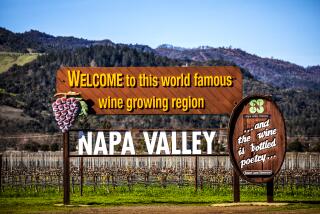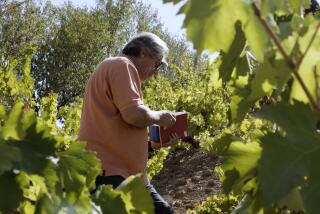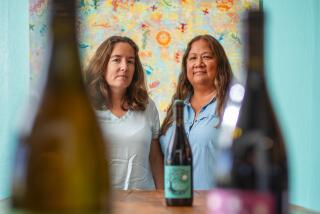Italians Get Serious About Chardonnays : Decent Red Wines From 1981-84 Also Available Now at Reasonable Prices
Italian vintners are unfamiliar with growing Chardonnay grapes and making them into wine. Yet producers from as far north as Alto Adige and as far south as Apulia are enthusiastically rushing to produce Italian Chardonnays.
Count Ugo Contini Bonacossi of the boutique-style Tuscan winery, Tenuta di Capezzana at Carmignano, near Florence, has been bitten by the bug.
Chianti and Carmignano, a DOC (Denominazione di Origine Controllata) red from Tuscany’s Montalbano Chianti region, have long been his winery’s staple wines, but Bonacossi claims his Chardonnay obsession is to compete for and cater to the American wine lover.
Labeled as Chardonnay, 1984, Vino Da Travola Di Toscana Capezzana, the wine bears no resemblance to either California Chardonnay or French white Burgundy. Other Italian Chardonnays don’t either, but that doesn’t mean they are poor wines any more than California generic Chablis is poor because it bears no resemblance to French Chablis.
Bonacossi takes Chardonnay very seriously. He knows his current offering is not the ultimate in style, but he is confident he will make it better as his 7-year-old Burgundy-cloned vines mature. The ‘84, priced at $7.50, offers a clean, austere taste with high acidity and a slightly tart lemony finish characteristic of many other Italian non-Chardonnay whites. It is not aggressively fruity, and its neutral flavor does beautifully at the table rather than at competitive tastings. It is a fine accompaniment for fish, stews and highly sauced veal and seafood dishes.
Bonacossi knows what it means to be an Italian wine pioneer. He has worked tirelessly to improve and promote Carmignano, his little-known red, with startling success. His Carmignano, DOC, 1982, is an exquisite wine with violet-like perfume, lovely claret-like concentration and generous flavors. It is elegant and can take several years of age but drinks beautifully now; a good buy at $10.
Keep in mind the wine is not a Chianti, which is generally produced from Sangiovese, Trebbiano, Malvasia and Canaiolo grapes. The Carmignano uses the same varieties except for a 10% inclusion of Cabernet Sauvignon. Bonacossi was instrumental in identifying Carmignano as a separate wine region from Chianti.
Carmignano, Reserva, 1981, DOC, is a bigger wine, although one with less perfume. It has layers of flavors without the concentration of the ’82. Nonetheless, the claret resemblance is there. Bonacossi contends that this is a feminine wine, lighter in structure, not massive or overpowering, designed for earlier maturity and consumption. “Reserva” requires three years of bottle age and two years in wood. It’s priced at $15.
Ghiaie Della Furba, Vine Da Tavola, Toscano, 1982, a red, is produced in the unusual Italian blend of 40% Cabernet Sauvignon, 30% Cabernet Franc and 30% Merlot. The wine takes its name from the deposits of pebbles of the vineyard and from the river Furba, which originates on the steep banks of Montalbano. It is generously long; a fine, subtle wine that is drinkable now, providing a mouthful of concentrated flavors that are a delight. Stored for one year in large casks, the wine will age, but the roundness and fullness of velvety harmonious flavors make early drinking a pleasure. It’s priced at $10.
The firm’s current Chianti wines, Montalbano, 1983 and 1984 are good modern-style Tuscan reds. Neither is produced by the old traditional governo method, which some authorities contend gave Chianti its unique zesty flavor and finish. The technique was simply the addition of must from 5% to 10% of the grapes, which had been set aside and semi-dried on mats, to normally fermented wine. The goal was to increase color, alcohol and glycerol through refermentation. Some of the area’s enologists believed the process left off-odors and caused excess oxidation.
The ’83 is easily the better, since ’84 was not the best year. Showing more elegant perfume and greater concentration and structure, it is a fine buy at $5.50. The ’84 is in a lighter mode. It displays some elegance and style but is not a candidate for long cellar aging. At $5.50, it makes sense only as an everyday light wine.
Another everyday red table wine is Capezzana’s Barco Reale, meaning “royal property.” This wine is designed for today’s consumption as distinguished from the firm’s prized Carmignano. Made from 80% Sangiovese, 10% Canaiolo and 10% Cabernet, it has little of the concentration found in Carmignano, but there is flavor and roundness that provide immediate pleasure. It’s worthy of a taste, particularly at $6.50.
All of the wines are made by Bonacossi’s son, Ugo, who studied at the Conegliano enology school. For two decades he has worked with his father to bring modern technology to this estate founded in the 15th Century.
The Carmignanos are not robust wines, but they exemplify excellent long flavor tones while achieving softness and a lovely velvety character that provides generous and pleasing consumption. This is the wine of the present and future for Capezzana and is one with which Americans will become increasingly familiar. They are wines of breed, and for reasons unknown to me, remain relatively inexpensive.
Ghiaie Della Furba, 1980, is available at around $3.99 and is an excellent drinking wine for today. No doubt the price is not related to its high quality but is a result of askew marketing, which has made the wine go largely unnoticed in the marketplace. All of this, and especially the cost, is likely to change as wine lovers discover the beauty and joy of this style.
More to Read
Eat your way across L.A.
Get our weekly Tasting Notes newsletter for reviews, news and more.
You may occasionally receive promotional content from the Los Angeles Times.









